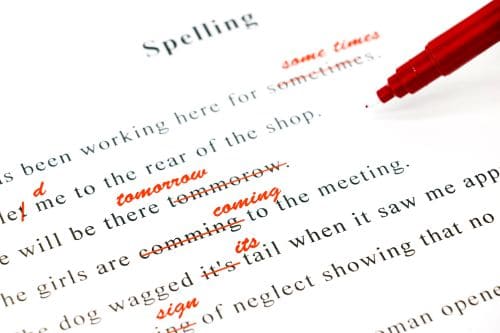Verification
IT IS IMPORTANT TO ENSURE THAT EVERY TEXT HAS BEEN TRANSLATED FULLY, CORRECTLY AND IN ACCORDANCE WITH THE ORIGINAL.

WHAT DOES IT INVOLVE?
We can come across verifications in many different contexts, such as the two-step name and password verification encountered when logging into an account on some website or other applications. This may involve us having to enter some relevant data as well as a code sent via SMS to our phone, such as during the two-step verification frequently used in online banking. This process confirms our identity and is intended to ensure that no hacker can access our account or data, including on our ID cards.
It can also mean the process of checking the skills of a job candidate. This type of verification process may take place during a job interview, when the job applicant is asked to perform a task related to the future position or to complete a language skills test.
Skrivanek uses a proprietary tool known as FOCUS for its language audits in companies – explore the possibilities!
So what does verification mean in terms of a translation?
DEFINITION: The PWN Dictionary of Polish Language indicates that verification is ‘checking the veracity, usefulness or correctness of something’. These three elements can be applied to a translation, where the verifier checks that the translation faithfully reproduces the original in terms of truthfulness, that it can fulfil its function usefully and that it is produced correctly.
The Oxford Dictionary states that the act of verification is ‘the act of showing or checking that something is true or accurate’, which also fits the translation verification process.
The ISO EN 17100:2015 standard, which also applies to translation services, provides several stages of the translation checking processes, including ‘verification’ and ‘revision’. ISO verification is the final step in the execution of an order, where the project manager verifies that the order has been executed according to the specification.
INDEPENDENT REVISION
This is the process of checking the translation against the original by a second, independent translator, which is also known as bilingual editing or independent verification. It involves checking that the translated content is consistent with the original and that the vocabulary is appropriate for the required industry or field. The verifier analyses the translated text in detail and compares it with the original text, checking that the translation is faithful to the original and that the text has been translated in a way that is appropriate for the purpose and context in which it is to be used.
A translator who is not only highly experienced but also has extensive knowledge in the field where the text functions is selected for the verification process. This is a matter of particular importance for specialised texts, including those in the technical, medical, financial and legal fields.
Proofreading is carried out by a native speaker of the target language, and includes the editorial proofreading carried out after the typesetting of translations intended for printing. To learn more about other types of correction, see here.

Do you need verification of the translation of documents, or maybe you want to check the linguistic correctness on your website? Write to us!



WHAT ELSE DOES A VERIFIER DO?
In addition to the factual assessment, the text reviewer also checks many other aspects that affect the quality of the translation. This involves the careful analysis of the spelling, stylistics and punctuation, all to eliminate any errors and other shortcomings. An important element here is also the comprehensibility of the translation, where the reviewer assesses the context and the overall readability of the text. They also pay attention to the consistency of the text, including the use of the same system of measurements, and whether the text uses numeric data consistently.
WHO VERIFIES A TRANSLATION?
The translator selected for a given project not only has extensive experience, but also a broad understanding of the field to which the text relates. This is a matter of particular importance when it comes to the revision of specialised technical, medical, financial and legal texts. Documents of this type require the use of specialised vocabulary and terminology that are not commonly known outside the field, as well as attention to terminological consistency. It is also essential to have enough experience and knowledge concerning communication and the industry standards. For these reasons, choosing the right person to do the process is a must.
WHY VERIFY?
The purpose of verifying a translation is to check that the text from the point of view of content, semantics and terminology – whether it fully corresponds to that found in the original text. This is important as even the most experienced translator, who has a great deal of knowledge in a given field, may make a mistake. This can occur in especially long and complex texts, where it is difficult to focus on every detail. It is therefore worth making sure that, through verification, that everything has been translated correctly.
The process of verifying a translation is a matter not only of linguistic correctness, but also of careful analysis of the content and context. A key step in revising a document or publication is to check and ensure terminological consistency, as the translator may apply inconsistent terms or constructions in different places, which may lead to ambiguity or disrupt the coherence of the text. The verifier’s task is to check that the text is coherent and understandable, and that the terms used by the translator are correct and used consistently, and in a manner that matches the industry standards.
Verification avoids errors and inaccuracies in the text, ensuring that the client receives a high-quality text that meets their expectations and requirements.
HOW IS A TEXT CHECKED?
The verification process involves the proofreader carefully reading the text several times in order to catch any mistakes. The proofreader analyses the translation to check and correct any inaccuracies, errors or omissions. Depending on the form of the file, they can either use a hard copy for this or conduct the process using a suitable computer program, such as Word or Adobe Acrobat Reader. Each error is then individually corrected.
Confidentiality is also an important aspect of the verification process. Where this concerns a certified translation, the person carrying out the revision is bound by the same rules of confidentiality as the actual translator.



WHY USE VERIFICATION?
If you want to ensure that there are no factual errors in the translated text, then it is important to use a proofreading service. If you wish to review a text translated by someone outside our agency, then it is important that you provide us with not only with the finished content, but also the source of the translation. It is also helpful to provide additional information, such as the specific vocabulary used by you or your company, including which synonyms are allowed and which we cannot use because they mean something different in each context, or which terms are preferred in the given field. By providing us with these materials, we can process the verification more quickly and efficiently.
Verification of a translated text is particularly important in the case of documents that are of great importance to the company or institution concerned. A mistranslation could damage reputations, lead to misunderstandings with clients or customers and even legal problems, and may even result in the creation of additional costs.
The same is true for texts on which someone’s health, life or safety may depend, such as prescriptions or medical recommendations, instruction manuals or court documents. Incorrectly translated instructions for a medical device or drug may endanger the health of a patient, while mistranslated court documents can affect the outcome of a lawsuit, leading to serious legal consequences.
In such cases, checking the translation by a second person is an indispensable part of the translation process. If you wish to avoid similar problems, it is worth investing in proofreading, to both detect any errors and give you confidence in the correctness of the translated text.
FOR WHICH LANGUAGE COMBINATIONS?
We provide translation verification services in all the language combinations we offer, both the more popular ones (e.g. English, German and French), as well as the less common ones (e.g. Azeri, Serbian or Flemish), including the type of text (contract, research results, article, website, text shared with clients, etc.).
We believe that professionally performed proofreading is the key to the correctness of any translated text, regardless of the type or language. That is why what we offer is aimed at companies and individuals who value quality and do not want to take the risk that their text will contain factual, semantic or terminological errors, and that the end result is both consistent and in line with the expectations.
You are also welcome to use the other elements that we offer, which includes translation, interpreting, website and application localisation, copywriting, language courses etc. See more detailed information in the other sections of our website.
VERIFYING MACHINE TRANSLATION
Automatic translation (MT) is very popular, which should not be surprising as a lot of content is translated using this method. Skrivanek also offers verification of translations made using the MT engine, whether it is your or our translation work.
Post-editing, as machine translation verification is also known, is a similar process to post-human verification, but there are some differences. MT engines tend to include some repetitive errors that need special attention. One of these is the use of an inappropriate style or the unnecessary translation of proper names. Posteditors, or machine translation proofreaders, are specialists who can correct a machine translation so that it is identical to one made by a professional.
If you want to discover whether post-editing is for you, take a look at our article on the subject!
VERIFYING AI CONTENT
It is becoming increasingly common for multilingual content not to be created by translating from one language, such as English or Polish, to other languages, but to be generated instantly in several languages using AI applications. In this case, it is also a good idea to proofread the content, especially if you plan to publish it, perhaps as a blog or social media post.
In the case of multilingual AI content, it is not possible to compare the original and the translation. However, it is possible to check whether the result is in line with our expectations in terms of style, vocabulary, degree of formality, etc.
If you need verification of your AI-created content, write to us! Also check out our Quick Review, a rapid and inexpensive revision service.
